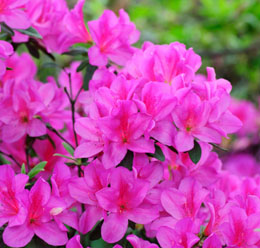Like every other plant, the azalea too, needs appropriate care and conditioning. In this article, we give you tips and tricks, which when used, will yield big, healthy, and beautiful azalea.

Azalea are flowering shrubs and sub-genera of the genus
Rhododendron. There are two sub-genera of
Rhododendron, the
Tsutsuji and
Pentanthera which are classified as azalea. These plants grow in damp mountainous places and their flowering season starts in spring.
An important thing to consider in azalea care is their sunlight requirement, which is lesser than what is required by other rhododendrons. They are, therefore, mostly found in shaded places, and once established in a particular setting, they grow easily, without much trouble. One doesn't have to pay much attention to these hardy plants after the basic requirements have been fulfilled.
Azalea need climatic conditions with moderate humidity and temperature for their growth. The temperature that is best suited for growing azaleas is 20° C. Hot and dry climatic conditions would cause unnecessary shedding of leaves. So, they should preferably be planted in a shady place. Also, azaleas grow well if planted near pines and oaks.
Soil Requirements
The soil with pH that is equal to or lesser than 5.5, is most suitable for growth of azaleas. Or, the soil that is suitable for growing trees like holly, pine, and oak may also give good results. You can check the soil's pH by carrying out specific tests. It is better to grow azalea in soil that is rich in organic matter.
Watering
Azalea plants require high amount of water. Prefer not to water them with sprinklers or by any other means that result in just superficial wetting of the plants. Water them at regular intervals and in such a manner that the soil is soaked/drenched completely.
Fertilizer Application
Cottonseed meal, an organic fertilizer, should be used for azaleas.
Pests and Diseases
Azalea plant is prone to fungal diseases and one way to prevent them is maintaining cleanliness around the stems and roots. Any decaying or dead leaves found near the trunk should be removed. Organic fungicides are the best option for keeping fungal diseases at bay.
Mulching
Mulching helps in preserving the soil's moisture around plant roots. It should be done in late autumn with shredded pine leaves. Mulching with hardwood barks should not be considered, as it causes the alkalinity of the soil to increase. The depth of mulch around the plant should be around 1 inch. Care should be taken to see that the stem is not covered. Keeping the stem and trunk free of mulch, helps in reducing rodent infestation.
Follow these essential and helpful tips to ensure proper and effective growth of azalea plants.






 Azalea are flowering shrubs and sub-genera of the genus Rhododendron. There are two sub-genera of Rhododendron, the Tsutsuji and Pentanthera which are classified as azalea. These plants grow in damp mountainous places and their flowering season starts in spring.
Azalea are flowering shrubs and sub-genera of the genus Rhododendron. There are two sub-genera of Rhododendron, the Tsutsuji and Pentanthera which are classified as azalea. These plants grow in damp mountainous places and their flowering season starts in spring.